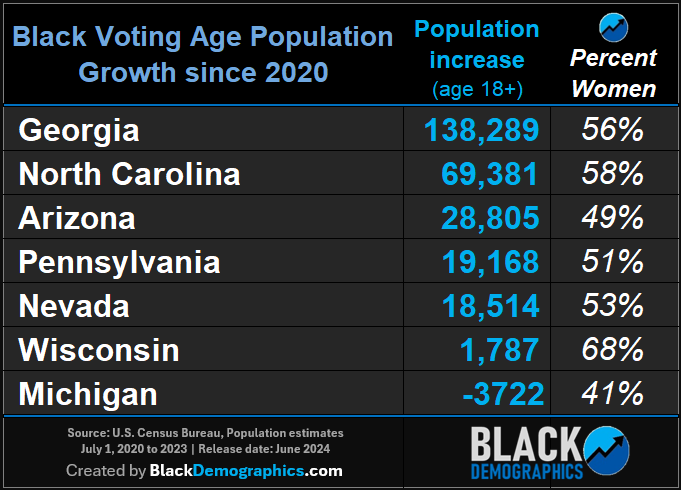Black Voting Age Population Growth in Key Swing States Since 2020
Recent U.S. Census Bureau estimates reveal significant changes in the Black voting-age population across several swing states since 2020. Here’s a summary of the key findings and their potential impact on future elections.
Georgia Leads the Pack
Georgia experienced the largest increase, adding 138,289 Black voting-age individuals, with women making up 56% of this growth. The Black population percentage in Georgia slightly rose from 32.0% in 2020 to 32.5% in 2023, underscoring the state’s growing diversity and its potential political impact.
North Carolina and Arizona: Significant Gains
North Carolina added 69,381 Black voting-age individuals, with women constituting 58% of this increase. The overall Black population percentage remained relatively stable, decreasing slightly from 21.5% to 21.4%.
Arizona saw an increase of 28,805 individuals, evenly split between men and women. The Black population percentage grew from 5.1% to 5.4%, reflecting broader demographic trends that could influence future elections.
Modest Increases in Pennsylvania and Nevada
Pennsylvania and Nevada saw moderate growth. Pennsylvania’s Black voting-age population increased by 19,168 individuals (51% women), with the Black population percentage rising from 11.2% to 11.4%.
Nevada added 18,514 individuals, with women making up 53% of this group. The Black population percentage increased from 9.9% to 10.3%. These changes, though modest, are significant for these battleground states.
Wisconsin: Small Increase, High Female Percentage
Wisconsin reported a small increase of 1,787 Black voting-age individuals, with women constituting 68% of this growth. The Black population percentage remained steady at 5.9%.
Michigan: A Decline to Watch
Michigan experienced a decline, losing 3,722 Black voting-age individuals, with women making up 41% of the remaining population. The Black population percentage slightly decreased from 13.5% to 13.4%.
Implications for Future Elections
The growth in the Black voting-age population in these swing states is crucial for shaping future political landscapes. With significant female representation in many states, the issues affecting Black women are likely to become more central in political campaigns and policy discussions.


